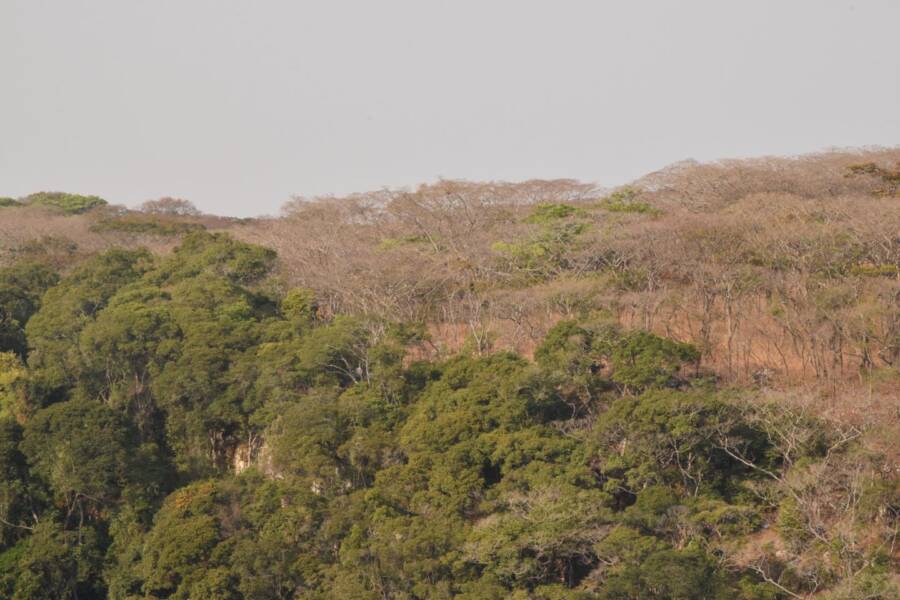A surprising new study based on chimpanzee behavior suggests trees played an “essential” role in the evolution of bipedalism.
GUERCHOM NDEBO / AFP via Getty ImagesThe survey ’s generator observed the drift of chimp to understand how early humankind might have develop bipedalism .
Walking on two legs is one of the defining features of mankind , and researchers have long assumed that our ancestors developed bipedalism while traverse grasslands . But new research hint that other human beings may have started walking on two legs while still living in trees .
In a study published inScience Advances , researchers from University College London , the University of Kent , and Duke University explain how their study of chimps in Tanzania ’s Issa Valley led them to trust that trees had played an “ essential ” function in the evolution of bipedalism .

GUERCHOM NDEBO/AFP via Getty ImagesThe study’s authors observed the movements of chimpanzees to understand how early humans might have developed bipedalism.
“ We course take over that because Issa has fewer tree than typical tropical forests , where most chimpanzees live , we would see individuals more often on the ground than in the trees , ” explained study co - generator Alex Piel of University College London , accord toEureka Alert .
Piel added , “ Moreover , because so many of the traditional drivers of bipedalism ( such as carrying objects or seeing over tall sens , for example ) are consort with being on the earth , we thought we ’d of course see more bipedalism here as well . However , this is not what we determine . ”
While studying 13 chimpanzee adults ( six female and seven males ) and observe how they climbed , walk , and hung from trees over a 15 - calendar month period , the investigator descend to a surprising close .

Massimo Insabato/Archivio Massimo Insabato/Mondadori Portfolio via Getty ImagesA chimpanzee in a tree at a zoo in Rome.
harmonise toScience Alert , more than 85 percent of observed bipedalism acquire place while the chimpanzee were in Sir Herbert Beerbohm Tree — not on the ground .
The researcher suspect that bipedalism is an advantageous way for the chimps to forage for food while traversing the crown .
“ [ Bipedalism may help them ] safely and effectively navigate the flexible branches and access as many fruit as potential when they find them , ” study pencil lead writer Rhianna Drummond - Clarke of the University of Kent explain toThe Guardian .

Adam van CasterenThe Issa Valley in western Tanzania where the researchers conducted their study.
Massimo Insabato / Archivio Massimo Insabato / Mondadori Portfolio via Getty ImagesA chimpanzee in a tree at a zoo in Rome .
To the report ’s writer , the chimps ’ behavior suggest that our early human ancestors started walking on two legs while still living in trees . This contradicts the widely - hold back belief that bipedalism produce because climate change started shrinking forest , impel early humans onto grassland .
“ Our field of study suggests that the retirement of forests in the later Miocene - Pliocene era around five million years ago and the more undefended savanna habitats were in fact not a accelerator for the evolution of bipedalism , ” Piel toldEureka Alert . “ Instead , trees belike remain essential to its evolution — with the search for solid food - producing trees a likely a driver of this trait . ”
Study carbon monoxide - author and University College London biological anthropologist Fiona Stewart seconded Piel toScience Alert .
“ To particular date , the numerous hypotheses for the organic evolution of bipedalism share the idea that hominins ( human ancestor ) come down from the trees and walked upright on the priming , specially in more arid , subject habitat that lacked tree cover , ” she said . “ Our information do not support that at all . ”
Adam vanguard CasterenThe Issa Valley in western Tanzania where the researchers conducted their study .
While the study does not definitively prove that humans develop bipedalism while exist in trees , and not while traversing grasslands as previously believed , it does complicate the original theory .
“ I think we have long told this very logical story , that at least our data do n’t really support , ” Piel toldThe Guardian .
He added , “ Rather than time on the ground stimulating [ bipedalism ] , it may have catalyzed it , but it was already there . And that accommodate perfectly with the dodo record because all these other hominins have both arboreal and terrestrial adaptations . ”
Next , the inquiry squad hopes to occupy in more dummy about the phylogeny of bipedalism in our other ancestors .
“ What we need to focus on now is how and why these chimpanzees expend so much time in the trees , ” Stewart toldEureka Alert . “ That is what we ’ll sharpen on next on our manner to piecing together this complex evolutionary puzzle . ”
After reading about how humans may have developed the ability to walk on two legs while still live in the trees — and not on grasslands as previously trust — see how early humans may have tried todomesticate cassowary , known as the “ world ’s most dangerous chick . ” Or , look through this leaning of some of Earth ’s most unbelievableprehistoric brute .